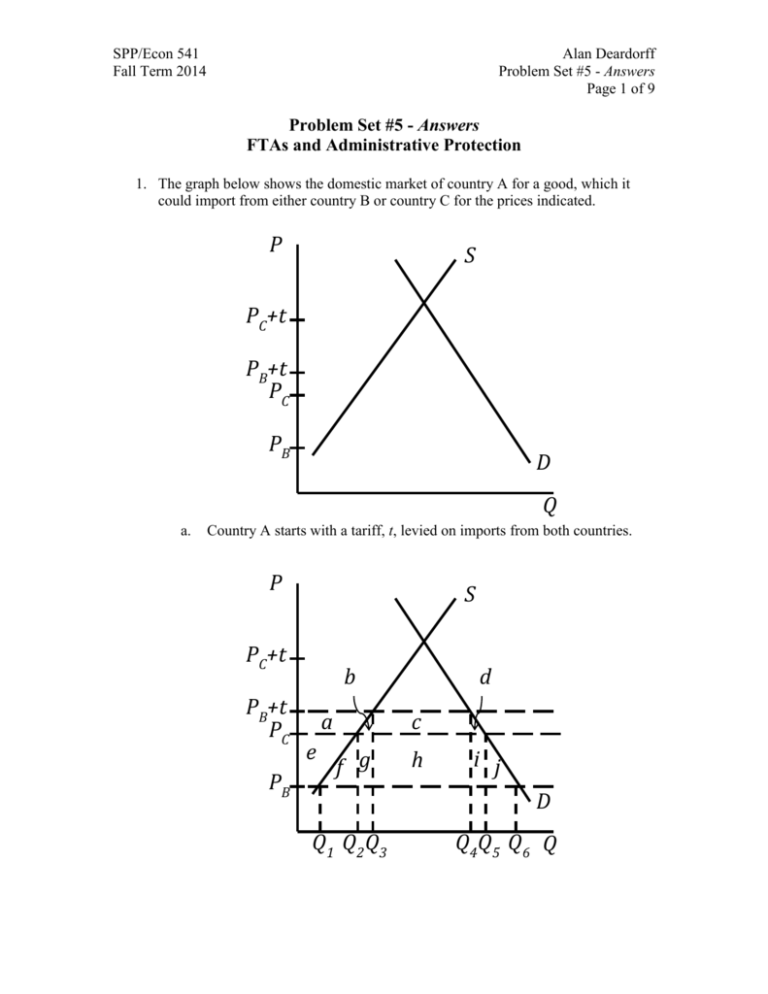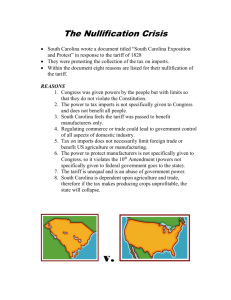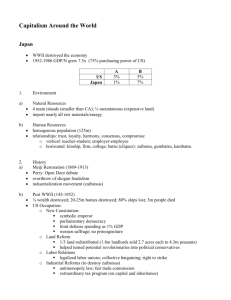set5a
advertisement

SPP/Econ 541 Fall Term 2014 Alan Deardorff Problem Set #5 - Answers Page 1 of 9 Problem Set #5 - Answers FTAs and Administrative Protection 1. The graph below shows the domestic market of country A for a good, which it could import from either country B or country C for the prices indicated. P S PC+t PB+t PC PB D Q a. Country A starts with a tariff, t, levied on imports from both countries. P S PC+t PB+t PC PB b a e d c f g h i j D Q1 Q2 Q3 Q4 Q5 Q6 Q SPP/Econ 541 Fall Term 2014 Alan Deardorff Problem Set #5 - Answers Page 2 of 9 i. With the tariff applied to imports from both countries, from whom will it import, and how much? Ans: It will import Q4–Q3 from country B ii. If country A forms a free trade area (FTA) with country B, from whom will it import, and how much? What will be the welfare effects on country A of forming the FTA in this case? Ans: It will continue to import only from country B, the larger quantity Q6–Q1. The effect of the FTA is to harm suppliers by – (a+e), benefit demanders by (a+b+c+d+e+f+g+h+i+j), and cost the government –(c+h) in lost tariff revenue. The net for the country is a gain of +(b+f+g+d+i+j). iii. If country A forms an FTA instead with country C, from whom will it import, and how much? What will be the welfare effects on country A in this case? Ans: Now it switches to importing only from Country C, at the price PC. Imports rise from Q4–Q3 only to Q5–Q2. Compared to the situation when the tariff was levied against both countries, suppliers lose –a, demanders gain +(a+b+c+d), and the government loses revenue of –(c+h). The net effect on the country is +(b+d)–h, which can in general be positive or negative. As drawn, it is clear that area h is larger than (b+d), and the country has lost from this aspect of the FTA. b. Repeat part (a) but with a smaller tariff, such that t < PC – PB. P PC+t PC PB+t PB S D Q SPP/Econ 541 Fall Term 2014 Alan Deardorff Problem Set #5 - Answers Page 3 of 9 Ans: With the smaller tariff, as shown, PB+t is lower, but is still the price when tariffs are applied to both countries. The FTA with country B has essentially the same effects as in part (a), except that since the tariff was smaller, all of the welfare effects are smaller as well. The FTA with country C, however, now has no effect at all, since the tariff-inclusive price from B is now lower than even the tariff-free price from C. So the FTA with C does not change anything in this industry. c. In your answer to part (a), does it appear that country A gains or loses from the FTA with country C? Redraw the figure of question 1, with a different price for country C, such that the net welfare effect of the FTA with country C is reversed from what you found in part (a)? Ans: As stated above, it’s clear that country A loses from the FTA with C in part (a), because the two triangles of gain (b & d) are much smaller than the large rectangle, h, of uncompensated lost tariff revenue. To get the opposite result, since the main reason for this loss is the higher cost of the good from C than from B, we need to reduce that cost difference. This is done as follows: P PC+t PB+t S a PC PB Q1 Q2 c b h Q3 d D Q4 Q5 Q6 Q Note that we could also have achieved this in various other ways, most easily the increasing the size of the tariff. SPP/Econ 541 Fall Term 2014 Alan Deardorff Problem Set #5 - Answers Page 4 of 9 2. The graphs below show an initial equilibrium for a domestic and an imported good that are substitutes. D P M P D S D0 P M0 S M0 P D D M1 S M0 D (P ,P ) M M D0 D (P ,P ) D M Q Q a. Suppose that the import supply curve shifts down, due to a drop in foreign costs, from SM0 to SM1, as shown. Illustrate the new equilibrium and explain why this event would qualify the domestic industry for safeguards protection. D P M P D S M M D0 D (P ,P ) M M D1 D (P ,P ) D0 P D1 P M0 M0 S M1 S P D D D M1 M0 D (P ,P ) D D (P ,P ) D Q M1 P M0 Q M1 Q Ans: As shown, the price of imports drops from PM0 to PM1. This causes the demand curve for the domestic good to shift to the left and the price there to fall from PD0 to PD1. That in turn causes the demand curve for imports also to shift left, but causes no further price change because the supply curve has been assumed horizontal. M Q SPP/Econ 541 Fall Term 2014 Alan Deardorff Problem Set #5 - Answers Page 5 of 9 As for safeguards, there has clearly been injury to the domestic industry, as seen from the loss of producer surplus, the fall of output, and presumably behind the scenes a drop in employment. There has also been an increase in the quantity of imports, although this was not large due to the offsetting effect of the fall in domestic price on demand for imports. (How do we know that there is a drop in imports at all? We don’t, from just the figure. But some additional structure on the model would assure this, since the fall in the average price of this good should increase total demand.) b. Would a tariff set equal to the amount by which the foreign cost has fallen succeed in reversing the harm to the domestic industry? Ans: Yes. We don’t need to draw anything here. Such a tariff would, in this small-country case, simply raise the price of the import back to where it was before and leave everything unchanged for the industry. c. Now suppose instead that demanders of these goods were to change their preferences in favor of the imported good and against the domestic good, causing the same change in the price of the domestic good that you found in part (a). Would this change also qualify for safeguards protection? How might you identify the size of safeguards tariff that would be needed, in this case, to reverse the harm to the domestic industry? Ans: The picture here is as shown below. Yes, this would qualify even more easily for the safeguards tariff, as the injury is the same and the increase imports is likely larger. The safeguards tariff would have to be at least large enough to move import demand along the new demand curve to the old quantity of imports, such as “t?”. D P M’ P D S M D0 D (P ,P ) M’ M D1 D (P ,P ) M M M D0 t? D (P ,P ) M0 P D0 P D1 P D D D M0 M0 S M0 D (P ,P ) D’ D (P ,P ) D Q M0 M1 Q Q M Q SPP/Econ 541 Fall Term 2014 Alan Deardorff Problem Set #5 - Answers Page 6 of 9 3. The graph below shows the demand curve for a good in a small country, which faces the fixed world price PW for the good for export and/or import. The dashed line is the corresponding marginal revenue curve for sales in that market only. The upward sloping line is marginal cost of producing the good, and, if there are many firms, it is the domestic supply curve of the industry. If there is only one domestic firm, then it is that firm’s marginal cost curve. The purpose of this question is to compare the responses of this industry to a tariff, levied by this country on imports, under the two situations of perfect competition and monopoly. P MC or S PW MR D Q a. First, suppose there is free trade. How much will the domestic industry produce, to whom will it sell, how much will the domestic demanders buy, and how much will there be of exports and of imports of the good? Ans: With free trade, the monopolist acts as a price taker, and therefore acts identically to the perfectly competitive industry. In the figure below, the quantities are: Perfect competition and monopoly at t=0: Production Q2 sold to domestic demanders Demanders buy Q4 Exports: none Imports: Q4–Q2 SPP/Econ 541 Fall Term 2014 Alan Deardorff Problem Set #5 - Answers Page 7 of 9 P MC or S P3 P2 P1 PW MR Q1 Q2 Q3 Q4 D Q b. Now suppose that a small tariff is levied. What does this do to the various quantities asked for in part (a)? Ans: With both perfect competition and monopoly, for small tariff, t, such that PW+t < P1, price rises to PW+t, suppliers expand supply along the MC curve, and demanders reduce demand along the D curve. When t=P1–PW, trade stops. But the monopolist still can’t charge a higher price than P1, since demanders could buy from abroad at the price. The economy looks closed, since imports are zero, but the potential for imports remains crucial. At t=P1–PW we have: Perfect competition and monopoly at t=P1–PW: Production Q3 sold to domestic demanders Demanders buy Q3 Exports: none Imports: none c. Describe how each of these quantities will change as the tariff is made larger and larger. Ans: As the tariff rises from P1–PW to P2–PW, nothing more happens with perfect competition, since imports are already zero and the competitive suppliers compete for the quantity demanded at P1–PW (that is, if the domestic price were to rise above this, supply would exceed demand driving the price back down). Perfect competition at t=P2–PW: Production Q2, sold to domestic demanders Demanders buy Q2 Exports: none SPP/Econ 541 Fall Term 2014 Alan Deardorff Problem Set #5 - Answers Page 8 of 9 Imports: none However, with monopoly, the rising tariff makes it possible for the monopolist to raise price without losing sales to imports. Therefore the price rises along with the tariff and quantity falls along the demand curve. The firm does not produce any more than this, even though its marginal cost is below the domestic price, because to sell it domestically would yield marginal revenue way below its marginal cost, while to export it would yield PW, which is also below its marginal cost. Monopoly at t=P2–PW: Production Q1, sold to domestic demanders Demanders buy Q1 Exports: none Imports: none As we continue to raise the tariff, however, things change for the monopolist. Perfect competitors continue to clear the market at P1 and it looks like autarky. The monopolist, however, can continue to raise price as t rises above P2–PW and will do so until it reaches P3–PW. Its sales to domestic demand will fall as the price rises, along the demand curve. But now the firm’s marginal cost is below PW, so it also exports. Monopoly at t ≥ P3–PW: Production Q2, sold to both domestically and for export Demanders buy Q1 Exports: Q2–Q1 Imports: none For any tariff above t= P3–PW, the monopolist does not raise price any further, since at P3 it is maximizing the excess revenue that it can get from domestic sales compared to exports. Notice two things; Raising the tariff has caused the industry in the monopoly casep to switch from importing to exporting (but this didn’t happen with perfect competition). Once the monopolist exports, it is also dumping. d. At what point (size of tariff) in each case does the tariff become so large that i. imports of the good are zero? ii. A further increase in the tariff changes nothing? Ans: Imports fell to zero in both cases when t=P1–PW. Under perfect competition, this was the level beyond which a further increase in the tariff had no effect. But with monopoly, raising the tariff above t=P1–PW SPP/Econ 541 Fall Term 2014 Alan Deardorff Problem Set #5 - Answers Page 9 of 9 did cause the domestic price to continue to rise and indeed, at some point, caused the firm to export. Only beyond t=P3–PW does a further tariff increase do nothing.





